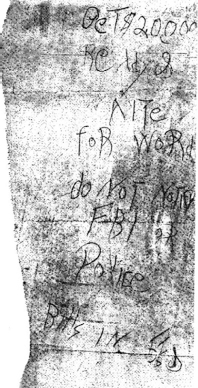Chapter 32
1945, The Beginning
September, 2012
The investigation was surpassing two years. Cameron and Neal had stated repeatedly, “It’s a good thing we didn’t stop ‘here’ because we didn’t even know about ‘this there’…” Edwards himself had said, “Don’t publish your book yet, there’s so much more you don’t know.…”
They had established a meticulous timeline of Edwards’ life dating back to when he was released from reform school in the late 40’s at age 17.
Cameron asked Neal, “How much further do you want to go? The killings are countless, he never quit.”
Neal answered, “When we release our findings, I think the floodgates will open. People will remember things, dates, phone calls, letters, maybe even Ed, all pertaining to unsolved murders that have no answers. There is one last place we need to look. It reminds me of Hannibal Lecter in ‘Silence of the Lambs.’ He told Clarisse, ‘You need to go back to the beginning.’”
They went back to the book and started once again. Edwards wasted no time establishing the book as not one hundred percent truthful. He claims he was born Charles Murray, yet he was born Charles Edwards Myers, after his grandfather. He also claims his mother died in December of 1935. He would’ve been only two at that time. Cameron proved otherwise, producing his mother’s death certificate with the August 8th, 1938 date, making Edwards five. His mother had been shot on August 2nd and lingered until August 8th. She was buried August 11th, in a Catholic cemetery.
Cameron explained, “He was adopted by Fred and Mary Edwards and they changed his name from Charles Myers to Edward Wayne Edwards. That in itself is suspicious because he was named after his grandfather. Why didn’t they want a connection to the family name? My guess is something horrible happened in that ‘suicide.’ Mary was stricken with MS and became bed ridden. Unable to care for him, he was sent to Parmadale Catholic Orphanage in January, 1940. He was 6, unloved, and unwanted. In December of 1946, the Bureau of Juvenile Research in Ohio did an evaluation. A copy of that eval is in the back of his book. The report states that Edwards ran away from Parmadale in March of 1945 at the age of 11.
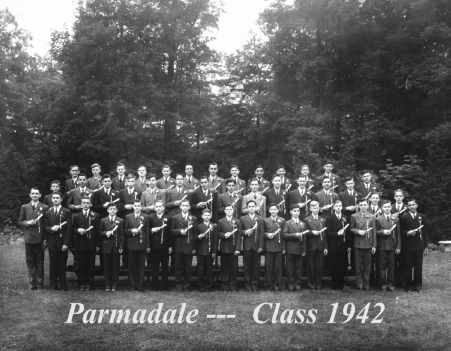
Parmadale Catholic Orphanage
“He then enrolled in St. Joseph’s Catholic School in Akron, but that lasted for a few months at best. His mother Mary died on October 5th, 1945 and by that fall, Edwards was clearly showing signs of serious problems. The psych eval notes he was molesting young girls on their way home from school and Dawn told me he was forcing pre-teen males and females, some as young as five, to perform sex acts in a tent in their back yard. Dawn was 6-7 years old.”
Neal interjected, “That gives me a little better understanding of Edwards’ childhood. He was born during the depression and by the time he gets out of Parmadale, World War II has just ended. Times were really tough then. It was difficult to buy a car, gas was rationed and the boys are just starting to come home from Europe.”
Cameron replied, “Interesting you’d comment on that. What I’ve been sharing with you has been leading up to the reason I called. I’ve found a new case. I think it was the beginning. I started researching the Ohio area for old crimes. This led me to a series of gruesome murders attributed to the Cleveland Torso Slayer. He was one of the country’s first serial killers. Here’s an article that came out right around the time of Ed’s mother’s death.”
The Sandusky Register
Sandusky’s oldest business institution——Founded 1822—-More than a century in your service
Sandusky, Ohio, Wednesday, August 17th, 1938
TWO MORE TORSO SLAYING VICTIMS
Apparent 11th and 12th Killings Laid to Mad Slayer Police are searching for a serial killer that left pieces of his 11th and 12th victims in public. They had been surgically dissected and parts were found in parks and near railroad cars.
While Neal glanced at the article, Cameron continued. “The press had it all over the papers. This was a prior serial killer who stalked Cleveland from 1933 until 1938. Looking at Edwards’ psych eval and realizing his first five years were formative years, this case was the foundation for his future killings. He mimicked murders his entire life, but it started right here.”
“In the second chapter of his book he brags to be scamming, burglarizing and robbing. He’s a young hood that has gone through puberty already. Dawn confirmed that. By 1945, he’s only 12 years old. He knows how to hotwire a car, forge checks, and ride the rails to access neighboring big cities. He makes two statements, on pages 25 and 26.”
“With my inner rage always at the boiling point, I was uncontrollable.”
“My foster mother asked me to help her out of bed, and we both fell to the floor—she never tried to get up again. My guilt about the incident always remained.”
“Just before his twelfth birthday, on June 5th, 1945, 45-year-old Josephine Ross was found stabbed and beaten to death in her Chicago home. Her head was wrapped in her dress. She was laid out much like Marilyn Sheppard in 1954 and Mrs. Robison in 1968. Six months later, Frances Brown was found in her bed with a knife lodged through her neck and a bullet wound to her head. Authorities attributed it to the same slayer. In all three cases the victims had adhesive tape placed on their bodies and they were all washed in a bathtub. Remember, Neal, JonBenet had tape placed over her mouth and so did the three little boys in Chicago in 1955.
“Here’s the clincher,” Cameron continued. “A note was written on the wall in lipstick.” He excitedly showed Neal a photo of the scene.
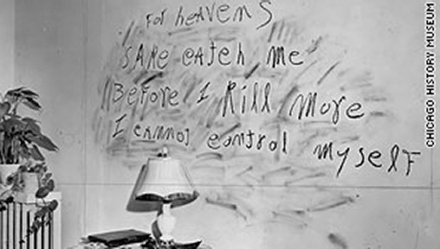
Chicago History Museum Photo of December 20th, 1945, Lipstick Killer Note
“Look, it’s just like he said in his book. ‘I cannot control myself.’ Remember, he has lost two mother figures by the age of 12 and is feeling abandoned with nowhere to go. He placed this time period in his book.”
“Wayne has been presenting behavior problems both at school and at home.… According to the police department, he was involved this summer in bicycle stealing and will not tell the truth even when the truth would be an advantage to him. His family background has distorted his character development very early. He lost two mother personalities, his own mother, whom he considered to be his aunt as long as she lived, and his adoptive mother.” *MOAC
“Remember when you told me the ego will strive for any attention, even if it’s negative? This is exemplified right here. It was the stressor.”
Neal exclaimed: “You have no idea what you just uncovered. Remember when you tied Melvin Belli and F. Lee Bailey together with the Zodiac and Marilyn Sheppard? The Zodiac wrote Belli in 1969.”
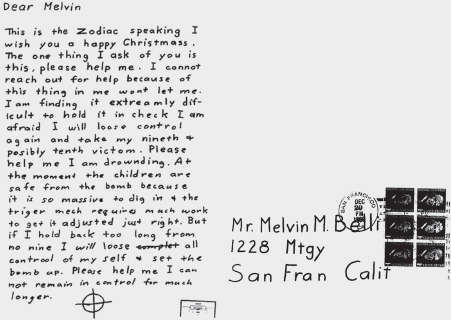
Zodiac’s December 20th 1969 Melvin Belli Letter and Envelope
Copy from Zodiackiller.com
“Please help me. I cannot reach out for help because of this thing in me won’t let me. I am afraid I will lose control. Please help me. I cannot remain in control for much longer.”
“Now look at the lipstick message on the wall.”
“For heAVenS SAKe catch Me BeFore I Kill more. I cannot control MyselF”
“Here’s something else—the handwriting. Do you have a copy of the Snook letter?”

Judge Snook Letter and Lipstick Message
Look at the letter C in Charles and Calif and compare it to the word CatCh in the lipstick message. They all look like E’s. The letter in 55 and the message in 46 were puzzles. The word eateh meant ‘catch Edward Edwards.’ He taunted the public with his identity in puzzles his entire life, not just in the Zodiac.”
Cameron replied, “This shows that the sensationalism started early. Listen to what his book says about his profile:
“It may be of interest to psychiatrists, sociologists, and social workers to learn that when Edwards was a youngster he was given tests which yielded the result he had an inferior I.Q. The young Edwards was at first diagnosed as having subnormal intelligence. That this was not true and was not the underlying cause of his criminal behavior was clearly documented by later diagnosis and behavior. On the contrary, Edwards was using his intelligence and ingenuity to mastermind devious, anti-social and illegal means for feeding his own need for recognition.”*MOAC age 12.
“The lipstick message confirms the psych eval. He was taunting the police to stop him way back then and leaving clues and messages at the age of 12.”
He continued, “I think he was acting out the killing of his own mother with these two murders. They led to the one I really want to tell you about. It’s the beginning. It set the groundwork for his killing of JonBenet in 1996. I want to tell you about the murder of a six-year-old blonde-haired, blue-eyed girl asleep in her own home in 1946. Her name was Suzanne Degnan.”
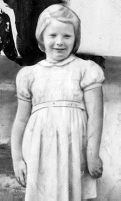
Suzanne Degnan, 1946
On January 6th, 1946, Suzanne Degnan was six years old. It was a Sunday night and Christmas vacation had just ended. She would be going back to Sacred Heart School in the morning. Her parents, Jim and Helen Degnan, shared a beautiful home with another family in the safe part of North Chicago. The Degnans lived upstairs.
Suzanne went to bed at her usual time. She had played earlier in the day with a nice-looking young man that had been hanging around the neighborhood, dressed nicely. Nobody knew who he was. Between 12 and 1 a.m., her mom thought she heard Suzanne crying. She fell back asleep and awoke at 6:00 a.m. to find a ransom note on the bedroom floor, the window open, a ladder propped against the sill and Suzanne missing.
“GeT $20,000 Reddy & wAITe foR WoRd. do NoT NoTify FBI oR Police. Bills IN 5’s & 10’s BuRN This FoR heR SAfTY”
Suzanne Degnan Ransom Note, January 6, 1946
The police arrived and declared it a kidnapping. The FBI was contacted. They waited to hear from the kidnapper(s), but the only phone calls received were unidentified and silent. The police received a phone call from an anonymous tipster instructing them to search the neighboring sewers. Sadly, the tip was accurate. Her dissected body was discovered beheaded and distributed underneath the streets of Chicago.
Police discovered the gruesome crime scene in the basement laundry room of a neighboring apartment building. The area had been cleansed and washed down, but blood was discovered in the drains beneath the laundry room sinks. A message written in lipstick was found on a telephone pole near the building.
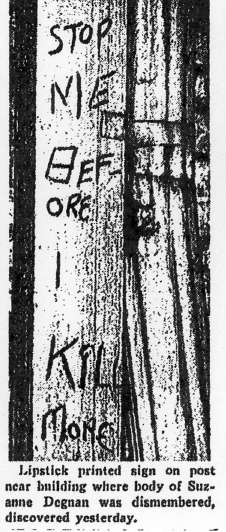
Lipstick Message, January, 1946
The nature of the note and usage of lipstick linked to the killing of Frances Brown, 6 months earlier. The police were now looking for a serial killer. The Chicago mayor received a chilling message stating Degnan’s father may have been the original target.
“This is to tell you how sorry I am not to get Ole Degnan instead of his girl. Roosevelt and the OPA made their own laws. Why shouldn’t I and a lot more.”
Suzanne’s father, Jim Degnan, was a senior executive at the OPA, the Office of Price Administration, a governmental agency started on August 28, 1941 by President Franklin D. Roosevelt. Their responsibilities included price controls and rationing. This policy resulted in food rationing at Parmadale Orphanage where Edwards spent his childhood years.
Eventually, a young con by the name of William Heirens was convicted and served 66 years with the Illinois Department of Corrections for the murder of Suzanne. He pleaded his entire life that he had been coerced into a confession. He died in prison at the age of 84, setting the record as the longest serving inmate. To this day, most believe he was innocent. The investigation by Cameron proved he was.
Neal asked Cameron, “Where do you even want to start? Sensationalism, letters to the press, wrongful conviction. Look at the connections! Kalitske and Bogle were killed just after New Years Day, the day before she was headed back to school. JonBenet Ramsey was the same age, killed on Christmas Day while her parents slept. The ransom note is even similar. I think the ladder shows she was lured out of her bedroom, not unlike Santa luring JonBenet down to the kitchen. In both cases, a ransom note with similar demands and the child is already dead. The note on the telephone pole, ‘Stop me before I kill more.’ It all fits! One final comment—’OLE Degnan’? He used ‘OLE’ Joe (Scolaro) and ‘OLE’ Impressio magazine in his notes in the Robison murders. That’s an unusual substitute for ‘old’—is too coincidental to be in both messages.”
Cameron said, “I want to put on my psychiatrist’s hat again and analyze Ed in 1946. Dawn is 7 years old at this time and has been interjected into Ed’s life. He is extremely jealous of the love and attention that she is getting from his aunt Edith Myers and feels totally alienated and rejected. He doesn’t feel loved. He mentions the significance of that in his book.
“Secondly, to point out the tremendous need for communication between the parent and the child and to emphasize how sorely needed in the average household of today is the words ‘I love you.’ Just as there is no substitute for discipline, there is no substitute for love. But, youngsters who grow up feeling that all their parents want from them is obedience—not love—tend to become resentful and rebellious.”*MOAC
“Listen to this psych eval that’s in the back of his book. It’s 1946.”
“There is indication of organic brain damage and some psychotic behavior. He is insecure, and sexual disturbance is present. There is an over-compliant, alert, pretentious front, but shallow and impoverished thinking. There is some tendency to pervert ideas, to misunderstand realities. The subject has great need for affection and recognition. Death is the way out of many difficulties which usually evolve around close relationships. Punishment causes the persons to be sorry they committed murder. His heroes find it necessary to implore supernatural help and he has no hesitancy meting out ‘hell’ for their punishment. There is sexual conflict suggestive of sadomasochistic nature. This boy is over- concerned with age and has a strong dislike for old people.”
“This eval explains why he murdered the older women and then the child. He was acting out his rage toward his aunt and his cousin, Dawn. He was screaming for attention of any kind. That’s why he murders and makes references to heroes and the supernatural. The part about no hesitancy ‘meting out hell’ for their punishment fits the role of Edwards as the Zodiac and executioner perfectly.”
Neal started getting a good picture in his mind. “Didn’t you say Degnan was chopped up in a laundry room in a basement? He took JonBenet to the basement! Additionally, there’s a part in Edwards’ book about luring young girls down into a laundry room for sex. It takes place about this same time-period.” Cameron found it in a chapter named, “The School Had Walls.”
“Around this time, I discovered what girls’ were for. Up to then, I hadn’t known what intercourse was. When I found out, I was all for it. ‘I had always viewed girls with great curiosity. But there was no young females in the reform school; on Mr. Day’s farm, I had no female company, and, as I said, the small town nearby had provided no outlet.
“I found I could get a lot of attention from girls, and I was delighted. Ironically, I became very particular about whom I went to bed with. The girl had to be feminine, and attractive, and had to care about me. I always chose younger girls whom I could dominate. For me, it was essential to excel. It was even necessary for me to beat girls at jumproping and jacks. I couldn’t abide a girl out-doing me in anything.
“Because my work involved various areas of the building, I occasionally got the opportunity to be with the girls. Once in a while, I was able to steal a couple of minutes to kiss a girl I especially liked. These brief contacts led to my working out a scheme. The laundry chutes led, from both the boys’ dormitories and the girls’ dormitories, to the same spot in the basement. I knew I would be down there sorting and washing clothes, and would be left alone for three to four hours. On a certain Saturday afternoon, I arranged that the girl I had been kissing and writing notes to would slide down the clothing chute from the girls’ dormitories into the basement.”*MOAC
Cameron exclaimed, “That’s it! You nailed it. Degnan was murdered on a Sunday; that’s why he said Saturday in the book. He groomed her the day before. He probably spent that afternoon beating her at jacks and hopscotch. Suzanne’s mother reported to police that a ‘nice young boy’ was hanging around the day before. Ed lured her out that window late at night, undetected by her parents, just like JonBenet 50 years later. Suzanne didn’t get carried out of that house. She went down that ladder knowingly and her mother heard her cry. She wouldn’t have gone with someone she didn’t know.”
Neal threw in, “John, I had no idea what you had been uncovering. Sometimes I get a little overwhelmed with the grisly details of Ed’s murders.”
“I understand, Neal. I have been doing this a long time and am a little cynical. I have another thread to JonBenet. A paper bag with red crayon markings was found with Suzanne’s right leg in a sewer. Edwards sketched a red heart on JonBenet’s right hand with a red crayon. It was more murder mimicry. That’s how Edwards ties his murders together.”
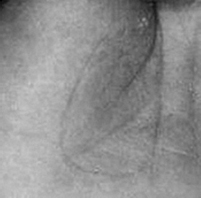
“Also, there was an attempt by police to go after Suzanne’s parents at first. Edwards didn’t succeed in getting John and Patsy Ramsey indicted—but he came close. Before they convicted Heirens of the Suzanne Degnan murder, he was asked, ‘Were your victims terrified when you killed them?’ He answered, ‘I can’t tell you, Sheriff, because I didn’t kill them. Please watch out, because the real killer is still out there.’ (William Heirens, October 1946). When asked, ‘Why did you confess?’ he said, ‘To avoid being executed. I couldn’t prove my innocence if I were dead!’
Cameron reiterated, “Despite 66 years of his effort, the press and the police never let up on him. He went to his grave known as ‘The Lipstick killer,’ when all he was, was a 17-year-old Chicago hood, that became Edwards’ fall guy. He died in prison March 5th, 2012, a year after Ed.”
Neal reminisced, “Burton Abbott might have gotten a life sentence in 1955 like Heirens, if he had confessed. But instead, he died in the gas chamber, a year after his conviction. Another innocent victim of Ed’s.”
Cameron stated, “This is horrible. People DO confess that are totally innocent. I have seen it first hand in my work. It’s all about the will to live. The power of the press is incredible, and Edwards realized it. By age 12 he was already creating ‘crimes of recognition’ and getting away with it, watching the press and public devour innocent men. From 1945 until 2011, Edwards killed non-stop, 66 years.
After discovering the beginning of Edwards’ murders, the importance of a detailed timeline became paramount. Edwards had started killing as a teen and just got better and better with time. Using all of their resources from the investigation, Cameron put together a complete time frame of Edwards’ life, with the help of Ed himself. Although “Metamorphosis of a Criminal” was the key to MOST everything; the letters Ed sent throughout his life were also puzzles. Ed knew that the future was the internet, and his book never made it on the internet for free. In fact, any hard copies still available were selling for as much as 1000 dollars in 2011. That did not leave a lot of people able to read it. Committing crimes for recognition took on a whole new meaning after Ed straightened Cameron out about its meaning:
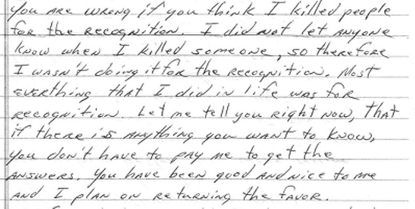
Ed Edwards to John Cameron, February, 2011
“He did not want to be recognized. He knew that eventually the world would realize his significance, if not in this life, then in his next…”
“I was all set to tackle the world. Someday people would hear of Ed Edwards, master criminal.”*MOAC
Cameron told Neal, “I want to go back to the book and his life one last time. My instincts says there’s more—a lot more!”
About a week later, Neal noticed a voice mail from Cameron. The message instructed him, “You need to come over right away.”
He wondered, “What did he find now?”
